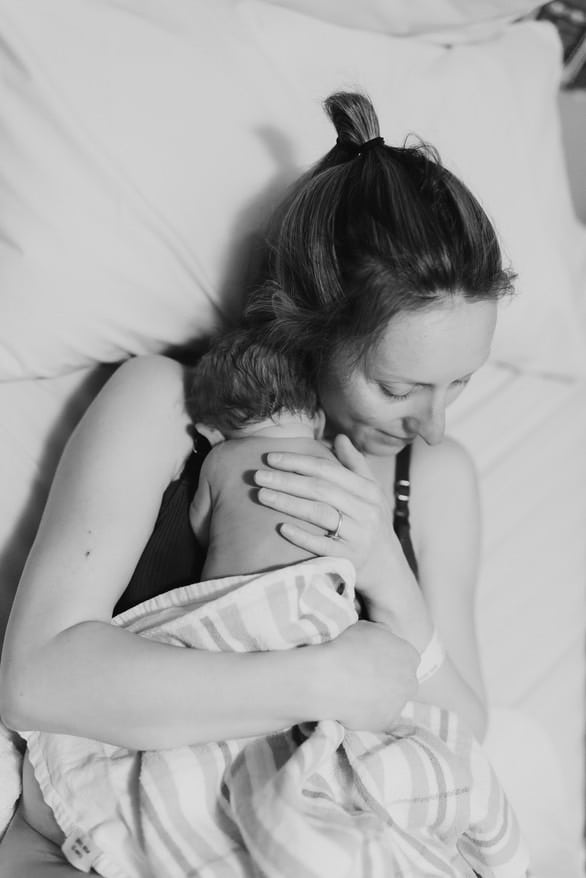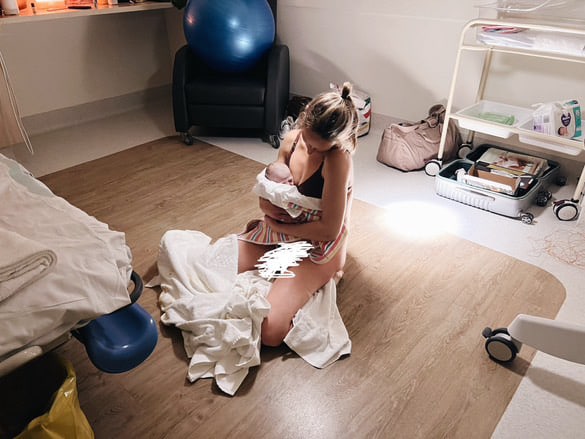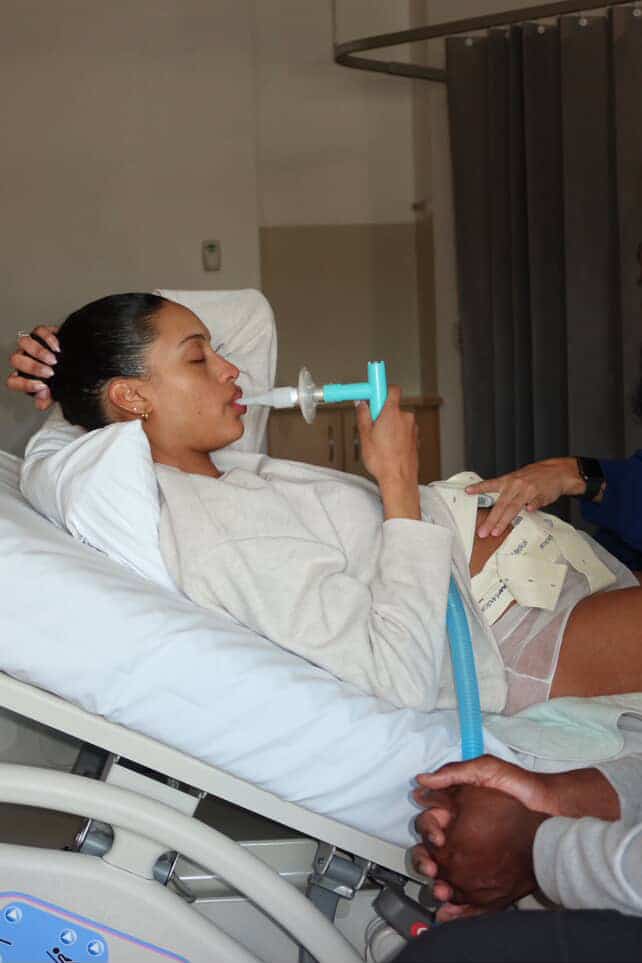Podcasts Heidi Sze – third birth story, preconception testing, nausea, early pregnancy bleeding, subchorionic haematoma, cholestasis
EPISODE 508
Heidi Sze – third birth story, preconception testing, nausea, early pregnancy bleeding, subchorionic haematoma, cholestasis

“I had been desperate to try for a baby for a couple of years. I always wanted three. I’m one of three. I don’t know. It just sort of goes that way sometimes. But we were in a place where we just really needed to wait. Ben my husband has long COVID. So it was June 2022 that he got COVID and then pericarditis from that. And then, I mean, he’s still got it with significant chest pain and fatigue. So, we wanted to sort of wait on that a bit and I was going through some mental health issues which I think started when my brother died. My older brother died when I was in my early 20s and then when I was postpartum with my second child, my sister-in-law got sick and a few months later died and left behind two beautiful kids and that really did something to me.”
Heidi opens up about the unique challenges she faced during this pregnancy, from supporting her husband’s recovery from long COVID to managing her own mental health needs in preparation for conception. She shares her proactive approach to health management, including thyroid monitoring, regular therapy sessions, and hormone tracking, all of which helped her determine when her body was best prepared for conception.
“We were in Queensland on holidays and we tested and it was a very, very, very faint line but I knew that like a line it’s positive. Ben was a bit suspicious, but I was like, no, it’s positive. And then I tested the next day and it was marginally darker. And to me, I just felt like I needed to see it get darker. We’d had a missed miscarriage between my eldest two, followed by a chemical pregnancy before I got pregnant with my second child. So I knew it could be a chemical pregnancy because the next day I tested and it was marginally lighter again and that’s what happened when I had the chemical pregnancy. I tested and then the next day it was lighter and then the next day I started bleeding. So, I expected that to happen but it didn’t. The test just remained super light. So, we came home and I had my HCG tested. I wasn’t expecting much but they were pretty high.”
Early into this pregnancy, Heidi began experiencing blood loss, which was very distressing. She was incredibly relieved to discover that the blood loss was caused by a subchorionic hematoma (when blood forms between a baby’s amniotic sac and the uterine wall) which thankfully resolved itself.
It wasn’t until 37 weeks that Heidi began to experience intense itching that she began to feel concerned.
“I started feeling itchy. And I knew, you know, sort of working adjacent to this space, like having some knowledge, I knew that itchiness wasn’t really good. It was maybe a sign to get checked out. But I was convincing myself, I’m like, I just wear a lot of wool. Like I have a lot of wool clothing. I think it’s just that I say, whilst furiously like scratching off my skin tags off my neck, it was brutal. So I went and got a blood test, checked on my liver function and it was slightly elevated, but my doctor was like, it could just be from the flu. Bile salts were okay, but a week later or five days later, the liver function was really high for enzymes. And my bile salts were out. So that was a cholestasis diagnosis, which I was just devastated about.”
“ At certain levels, you need to be induced (due to cholestasis) and sometimes immediately because if they get to a certain level, there is an increased risk of still which is scary. And so I was really taking it seriously. My levels were borderline needing to be induced at 38 weeks. And then I also got it tested a couple of days later and it’s lower again, but my obstetrician said they can swing. And so in the back of my mind was they could also swing higher. I don’t not want to be induced as much as I did not want to have an induction. I loved going into spontaneous labour. My other two. And I love not knowing when’s it going to happen.”
Heidi shares “ I felt okay with the number of weeks. I felt quite excited to not be itching again, but I also felt like it didn’t give me a lot of time to go into spontaneous labour before the induction because I wanted my body to do it on its own. So I was like, okay, I said to Natalie, do I need to be induced tomorrow or can I have the weekend? This was on a Wednesday. And she said, no, you can have the weekend. We booked in for the Monday. She, we talked through different things I could do to help try to bring labour on.”
“I was preparing for Monday. So I wrote an induction birth preference list.. I requested to have a little bit of time after my waters were broken. So the plan was to break my water straight away because she could stretch me to two cm in the stretch and sweep. I wouldn’t need the balloon or whatever the first step can sometimes be. And Natalie said, yep, you know, obviously depends on if your waters are clear, you know, there’s, there’s things we’ll talk about, but if that feels right and if that seems to be safe, then absolutely we can wait a little bit to see if I can, if that can kickstart labour. Then also the drip would be started very, very, very low. Um, and things from there and I think being a third-time labourer, they were thinking that I wouldn’t need much and I was hoping that that would be the case as well. So, I did have one more thing that I was going to try before the induction happened. I’d spoken to Natalie, my obstetrician about.
“Natalie’s suggestion based on my circumstances, my unique situation, was that I could possibly, if I wanted to, try a little bit of castor oil, which I was surprised about because that sort of felt old school midwifery to me. And I’d heard about it and I’d heard of lots of people just trying it, you know, it’s like a last-ditch attempt, but I was really interested. She suggested, you know, quite a conservative amount and I say this not encouraging people to just go out and do it because I do think it’s an intervention that needs to be done with, you know, monitoring and with thought from your healthcare provider and some research on your behalf. I did a ton of research on it. Evidence-based birth has some information and they link to different studies and I came to a point based on my situation. There’s lots to consider. So, I trusted Natalie. That was her advice based on my situation. It’s not like she would say, everyone do this. And I was really unsure if I wanted to. But I ummed and ah’d and Sunday morning came around. It was Father’s Day. My parents were coming over for for brunch. And I thought I’m just gonna do it. I’m just gonna have this small amount. Maybe it’ll help ripen my cervix.”
To hear how Heidi used castor oil before her scheduled induction and the details of Philips’s birth tune into episode 508 of the podcast.






Topics Discussed
castor oil, Cholestasis, early pregnancy bleeding, Nausea, preconception testing, subchorionic haematoma, thyroid function
Episode Sponsor
We’re celebrating Spring with a spring time sale!
Enjoy 20% off our online courses for a limited time.
The Birth Class was $249 now $199
The Birth Bundle was $349 now $279
Discovering Motherhood was $119 now $95
Welcome to the First Trimester was $67 now $53
Just use code ‘SPRING24‘ at checkout.
Hurry – this offer is only valid until 31 October 2024.
Categories
Related Products
-
Birth Combs: Harness Your Body’s Natural Pain Relief
$24.95Crafted from smooth, natural wood, our birth combs activate specific pressure points in your hands that trigger your body’s innate pain-relieving responses.
Join the conversation
Sign up to get the latest updates, freebies, podcast releases straight into your inbox
@AustralianBirthStories
Follow along with us
@AustralianBirthStories
Follow along with us
@AustralianBirthStories
Follow along with us
@AustralianBirthStories
Follow along with us
@AustralianBirthStories
Follow along with us
@AustralianBirthStories
Follow along with us
@AustralianBirthStories
Follow along with us
@AustralianBirthStories
Follow along with us
@AustralianBirthStories
Follow along with us
@AustralianBirthStories
Follow along with us
@AustralianBirthStories
Follow along with us
@AustralianBirthStories
Follow along with us






